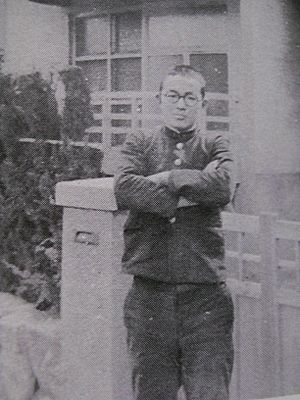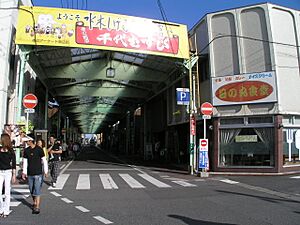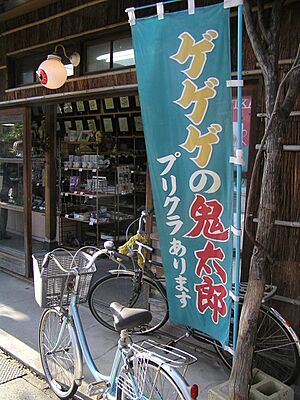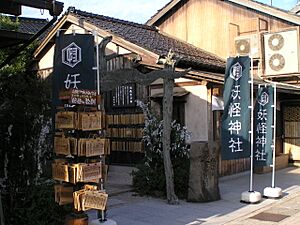Shigeru Mizuki facts for kids
Quick facts for kids Shigeru Mizuki水木 しげる |
|
|---|---|
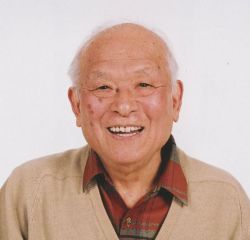 |
|
| Born | Shigeru Mura March 8, 1922 Osaka, Osaka Prefecture, Japan |
| Died | November 30, 2015 (aged 93) Tokyo, Japan |
| Nationality | Japanese |
| Area(s) | Writer, penciller, inker, manga artist |
|
Notable works
|
GeGeGe no Kitarō Onward Towards Our Noble Deaths Akuma-kun Showa: A History of Japan Hitler |
| Awards | See below |
Shigeru Mura (born March 8, 1922 – died November 30, 2015) was a famous Japanese manga artist and historian. He was also known as Shigeru Mizuki. He became well-known for his manga about yōkai (Japanese spirits or monsters). Some of his most famous yōkai manga include GeGeGe no Kitarō and Akuma-kun. He also created powerful war stories, often based on his own experiences, like Shōwa-shi.
Shigeru Mizuki was born in Osaka, Japan. He grew up in a city called Sakaiminato, Tottori. Later, he moved to Chōfu, Tokyo, where he lived for the rest of his life. His pen name, Mizuki, came from an inn he once managed. It was called 'Mizuki Manor', and he drew pictures for a type of street theater called kamishibai there.
Contents
Life Story
Shigeru Mizuki was born as Shigeru Mura in Osaka. He was the second of three sons. He spent most of his childhood in the coastal city of Sakaiminato. As a child, he was quite active and often played "warfare" games with other kids.
From a young age, Mizuki showed a special talent for drawing. His elementary school teachers were very impressed by his art. They even held an exhibition of his work. He was later featured in a newspaper as a young art genius.
Besides art, Mizuki was very interested in supernatural stories. A local woman named Fusa Kageyama, whom he called "Nononba," often told him ghost stories. These stories greatly fueled his interest in the world of yōkai.
Wartime Experiences
In 1942, Mizuki was called to join the Imperial Japanese Army. He was sent to New Britain Island in Papua New Guinea. His time in the war changed him deeply. He caught malaria and saw many friends die from injuries and sickness. He experienced many other terrible things during the war.
During an air raid by the Allied forces, he was caught in an explosion. This caused him to lose his left arm. Mizuki later said that he was the only one from his unit who survived. He felt that he was "ordered to die," which he thought was a ridiculous idea.
Because of his war experiences, Mizuki became a strong believer in peace. He explained that his yōkai characters can only be seen when there is peace, not war. He made these supernatural creatures without any specific ethnicity or nationality. This was his way of showing that all people can live together peacefully.
While in a Japanese hospital in Rabaul, he became friends with the local Tolai tribespeople. They even offered him land, a home, and a chance to become one of them by marrying a Tolai woman. Mizuki thought about staying, but a military doctor convinced him to return to Japan for medical care and to see his parents. He went back, but he was not happy about it.
After the War
When he returned home, Mizuki had planned to go back to New Guinea. However, the occupation of Japan changed his plans. His injuries also made things difficult. His older brother, who was an army officer, was found guilty of war crimes. This was because he had ordered prisoners of war to be killed.
After returning to Japan, Mizuki worked many different jobs. He sold fish and also worked as a kamishibai artist.
In 1957, Mizuki released his first work, called Rocketman. After that, he published many more stories. Some were about the military, and others were about yōkai. He also wrote many books on both topics. This included a manga biography of Adolf Hitler in 1971. This book was later published in English in 2015.
Mizuki started a manga version of the kamishibai story Hakaba Kitarō in 1960. In 1965, it was renamed Kappa no Sanpei. It then began to appear regularly in Weekly Shōnen Magazine. In 1967, it was renamed again to GeGeGe no Kitarō, which became very famous.
In 1972, he published the graphic novel Nonnonba. This book was about his childhood friendship with an old woman who told him many yōkai stories.
Later Works and Recognition
In 1991, Mizuki released a short work called War and Japan. This story was published in a popular magazine for young people. It showed the terrible things the Japanese Army did in China and Korea. The character Nezumi Otoko narrated the story. Mizuki used this work to show his anger at those responsible for the victims of war.
From 1989 to 1998, he worked on Showa: A History of Japan. This series also showed Mizuki's view of the Shōwa era (a period in Japanese history). He mixed his own personal stories with summaries of important historical events. His character Nezumi Otoko often appeared as the narrator in these works too.
When he wasn't working on manga, Mizuki also painted many subjects. However, his paintings are not as well known as his famous manga. In 2003, he went back to Rabaul to visit his friends there. The local people had even named a road after him to honor him.
In 2005, Mizuki made a small appearance in the movie Yōkai Daisenso (The Great Yokai War). This film was about yōkai and was inspired by his work. He played the role of the Great Elder Yōkai. This character was a peaceful one who spoke against war. He also reminded everyone that yōkai are usually peaceful and playful creatures.
In 2010, the TV channel NHK broadcast a morning drama series about his married life. It was called Gegege no Nyōbō and was based on his wife's autobiography.
For most of his life, Mizuki's work was not well known outside Japan. This was because it had not been translated into other languages. But in the 2010s, his works began to be translated into several European languages. This included his Showa, Kitaro, Nonnonba, and Hitler series. This led to more people in Western countries becoming interested in Mizuki and his amazing work.
On November 30, 2015, Shigeru Mizuki passed away from heart failure in a Tokyo hospital. He had collapsed at his home from a heart attack.
Bakeichōnosei
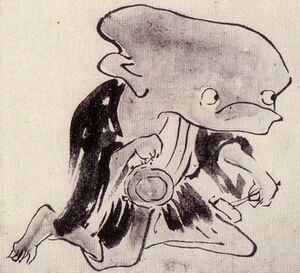
Bakeichōnosei (ばけいちょうのせい) is a Japanese monster or spirit. It means "monster ginkgo spirit." This creature was written about by the yōkai manga artist Shigeru Mizuki.
It is said that this monster has yellow limbs and face. It wears a kimono dyed with inkstick and strikes a gong. Ginkgo biloba trees have long been thought to be unlucky in some stories. Planting them at home was sometimes believed to cause bad things to happen.
Mizuki drew this monster based on an old drawing. It was called "Kamakura Wakamiya Hachiman Teru (Ginkgo) Teru no Kibana." This drawing was part of Yosa Buson's "Kabmura Yokai Emaki" collection. According to a yōkai researcher named Goichi Yumoto, the Kabumura sculpture is thought to be a symbol of an old tree spirit.
Sakaiminato, His Hometown
Sakaiminato was Shigeru Mizuki's childhood home. This city now has a special street dedicated to the ghosts and monsters from his stories. One hundred bronze statues of his characters line both sides of the road. There is also a museum in Sakaiminato that features many of his creations and works.
Awards and Honors
Mizuki received many awards and honors for his works. His series GeGeGe no Kitarō was especially recognized. Here are some of his awards:
- 1965 He won the Kodansha Jido Manga Award for his work Terebi-kun.
- 1990 He received the Kodansha Manga Award for Komikku Shōwa-Shi.
- 1991 He was given the Shiju Hōshō Decoration, a Japanese honor.
- 1995 For the 6th Annual Tokyo Peace Day, an exhibition of his paintings was held. It was called "Prayer for Peace: Shigeru Mizuki War Experience Painting Exhibition."
- 1996 He received the Minister of Education Award.
- 1996 His hometown of Sakaiminato honored him with the Shigeru Mizuki Road. This street is decorated with bronze statues of his Ge Ge Ge no Kitaro characters.
- 2003 He received the Kyokujitsu Shō Decoration, another high Japanese honor.
- 2003 Sakaiminato honored him again with the Shigeru Mizuki International Cultural Center.
- 2003 He won the Tezuka Osamu Cultural Prize Special Award for his works.
- 2007 He received the Best Comic Book award for NonNonBā. This was at the Angoulême International Comics Festival in France.
- 2008 He won the Asahi Prize. This was for his contributions to manga culture by showing the horrors of war.
- 2010 He received the Person of Cultural Merit award.
- 2012 He won the Eisner Award for Onward Towards Our Noble Deaths. This was in the category of Best U.S. Edition of International Material – Asia. He shared the award with his translator, Zack Davisson.
Selected Works
Here are some of Shigeru Mizuki's important works:
In English
- GeGeGe no Kitarō (ゲゲゲの鬼太郎, 1960–1969)
- Hitler (劇画ヒットラー, Gekiga Hittorā, 1971)
- Onward Towards Our Noble Deaths (総員玉砕せよ!, Sōin Gyokusai Seyo!, 1973)
- NonNonBa (のんのんばあとオレ, Nonnonba to Ore, 1977)
- Showa: A History of Japan (コミック昭和史, Komikku Shōwa-shi, 1988–1989)
Manga in Japanese
- Rocketman (1957)
- Baby Z, for the sci-fi magazine Uchū Shonen
- Hakaba Kitaro (1960–1964)
- Kappa no Sanpei (河童の三平, 1961–1962)
- Akuma-kun (1963–1964)
- Terebi-kun (テレビくん, 1965)
- Kaiten, the human torpedo (1967)
- The Miraculous Notebook (不思議な手帖, Fushigina Techō, 1973) — This was a short story about a notebook that could kill anyone whose name was written in it. This idea was later used in the popular manga Death Note.
- Watashi no Hibi (わたしの日々), ("My Days)" (2013, unfinished)
Books
- Colorized Yōkai Gadan, 1992
- Shigeru Mizuki's Yōkai Artbook: Mujara, 1998
- Mizuki Shigeru no Nihon Yōkai Meguri (lit. "Shigeru Mizuki's Japanese Ghost Tour")
- Rabauru Senki (Memories of Rabaul)
- Graphic World of Japanese Phantoms, 1985
- Yokaï, 2017 (an illustration book)
- À l'intérieur des yôkai, 2018
- À l’intérieur de Kitaro, 2018
See also
 In Spanish: Shigeru Mizuki para niños
In Spanish: Shigeru Mizuki para niños


